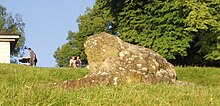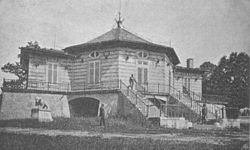Bärenschlössle
The Bärenschlössle in Stuttgart's Rotwildpark was originally a pleasure palace and now serves as a restaurant. It was named after the Bärenbach (now Bernhardsbach ) that flowed near it. The Bärenschlössle and the lakes in the forest belong to the "district" Wildpark in the Stuttgart-West district .
The first building: Carl Eugen pleasure palace

The first Bärenschlössle was built by Reinhard Ferdinand Heinrich Fischer , a student of the French architect Philippe de La Guêpière , under Duke Carl Eugen in 1768 in the "old Roman" style made of stone. From the two-storey oval pavilion one had a view of the artificially created Bear Lake , on which gondolas floated that Carl Eugen had brought back from a trip to Italy in 1766/67 or had built according to the Italian originals. It was a secondary plant to the main Solitude plant connected by a three kilometer long route axis . The area around the Bear Lake was a fallow deer garden that was part of the Solitude Wildlife Park.
The Venetian lion figures that mark the former landing site at Bear Lake are a reminder of this phase. On the ground floor there was a room with wall paintings, on the first floor a drawing room with a ceiling painting by Nicolas Guibal . There is a picture of this first building on a coffee pot, which is kept in Ludwigsburg , and an etching by Nikolaus Heideloff , which is in the Stuttgart City Archives under inventory number B 7485. It shows a hunt in honor of Grand Duke Paul of Russia, which was held on September 24, 1782.
After Carl Eugen's death in the fall of 1793, both the castle and the watercraft came down. In 1817 the first Bärenschlössle was demolished.
The second building: Wilhelm I's hunting pavilion
In the same year, King Wilhelm von Württemberg had a larger, octagonal hunting pavilion with two wings built on the site of the previous building. This was from Freudental translocated . The king expanded the park into a large game reserve in order to be able to organize show hunts on the site. The pavilion was built in the classical style on a terrace and had a hall that was decorated with hunting trophies and hunting pictures by E. Kehrer. The outside of the pavilion was originally clad with bark and also carried hunting trophies.
Two cast zinc bear statues by Albert Güldenstein (1863/1864) stood near the pavilion. One of these figures was found again after the Second World War and served as a template for the two bronze bears created by Lilli Kerzinger-Werth in 1964 , which are still standing by the building today.
Until the First World War, the park and palace were only accessible to those with an annual pass; In 1919 the fence around the wildlife park was removed and the area was open to the public. From 1937 the pavilion was used as a guest house for the state and the city of Stuttgart. In the same year the game reserve was fenced in again. The red deer park has been a nature reserve since 1939 and the wild boar park since 1958.
The third building: reconstruction after the effects of the war
An incendiary bomb almost completely destroyed the old hunting pavilion in 1943. However, it was rebuilt in 1963 on the terrace that had been preserved. The ground floor was designed as a restaurant, the upper floor as an open hall.
The fourth building: reconstruction after a fire
On November 13, 1994, the Bärenschlössle burned down almost completely. The building was rebuilt close to the original until 1997; The double doors on the upper floor, which replaced the windows in the previous buildings, differ from the two previous buildings.
use
The Bärenschlössle is used today as a restaurant and event location. As it is located in a nature reserve, its use is subject to certain restrictions.
Web links
Individual evidence
- ↑ Hartmut Ellrich, p. 150 (see lit.)
- ↑ Here it is claimed that the image on the jug is the only one known.
- ↑ Hartmut Ellrich, p. 151 (see lit.)
literature
- Hartmut Ellrich: The historic Stuttgart. Michael Imhof Verlag GmbH & Co.KG, ISBN 978-3-86568-381-6 , pages 150-151.
- Baden and Württemberg in the Age of Napoleon, Volume 1,2: Catalog. Stuttgart 1987, page 569, 571.
Coordinates: 48 ° 45 ′ 39 " N , 9 ° 5 ′ 29.2" E





